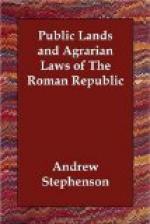rolls. The number of persons settled on the Campanus
ager is said[8] to have been 20,000 citizens who
had each three children or more. The land was
not distributed by lot, but at the pleasure of the
commissioners, each one receiving some 30 jugera.[9]
If 20,000 heads of families with their wives and three
children in each family were settled in Campania, the
whole number of settlers would be 100,000. This
great number could scarcely leave Rome at one time,
and we find that as late as 51 the land was not all
assigned.[10] While the tenor of the law does not
imply that it was the intention to reward military
service with grants of land, yet we may be sure that
the veterans of Pompey were not forgotten.[11] There
are no extant authorities which speak of the settlement
of the Campanian land that say any thing about the
soldiers settled there, unless it be Cicero. He
speaks of the Campanian territory being taken out
of the class that contributed a revenue to the state
in order that it might be given to soldiers,[12] and
he appears to refer to this time (59). Mommsen
says that “the old soldiers as well as the temporary
lessees to be ejected were simply recommended to the
special consideration of the land distributors."[13]
These latter were a commission of twenty appointed
by the state. Caesar, at his own request, was
excused from serving, but Pompey and Crassus were the
chief ones, thus furnishing sufficient reason for
supposing that the soldier was provided for.
The passage of this bill amounted in substance to the
reestablishment of the democratic colony founded by
Marius and Cinna and afterwards abolished by Sulla.[14]
Capua now became a Roman colony after having had no
municipal constitution for one hundred and fifty-two
years, when the city with all its dependencies was
made a prefecture administered by a prefect of Rome.
The revenues from this district were doubtless no longer
needed, as those from Pontus and Syria[15] supplied
all the needs of the government, but it is difficult
to see what benefit could be reaped from the ejection
of the thrifty farmers who, as tenants of the state,
cultivated this territory and paid their rents regularly
into the state coffers. Wherever the new settlers
were brought in, the old cultivators were turned out.
No ancient writer says anything about the condition
of these people. Cicero, in his second speech
upon the land bill of Rullus, when speaking of the
consequences that would follow its enactment, declared
that if the Campanian cultivators were ejected they
would have no place to go, and he truly says that
such a measure would not be a settlement of plebeians
upon the land, but an ejection and expulsion of them
from it.[16]
Did it pay to send out a swarm of 100,000 idle paupers[17] who, for two generations, had been fed at the public charge from the corn-bins of Rome, simply in order that a like number of honest peasants, who had been not only self-supporting but had paid a large part of the Roman revenue, should be compelled to sacrifice their goods in a glutted market and become debauched and idle?




